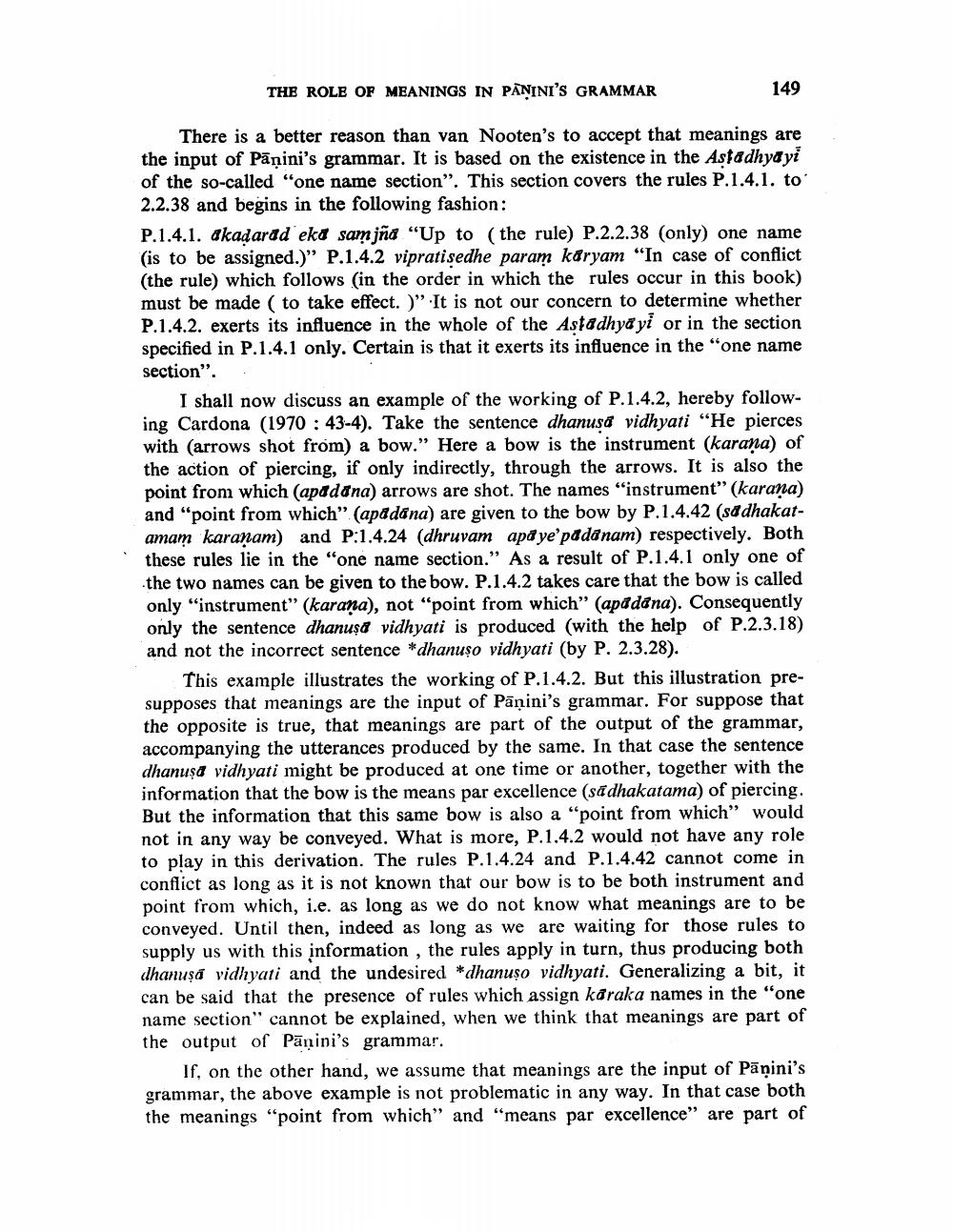Book Title: Role Of Meanings Uin Paninis Grammar Author(s): Johannes Bronkhorst Publisher: Johannes Bronkhorst View full book textPage 4
________________ THE ROLE OF MEANINGS IN PANINI'S GRAMMAR 149 There is a better reason than van Nooten's to accept that meanings are the input of Pāṇini's grammar. It is based on the existence in the Astadhyd yi of the so-called "one name section". This section covers the rules P.1.4.1. to' 2.2.38 and begins in the following fashion: P.1.4.1. akadarad eko sam jña “Up to (the rule) P.2.2.38 (only) one name (is to be assigned.)" P.1.4.2 viprati sedhe param karyam "In case of conflict (the rule) which follows (in the order in which the rules occur in this book) must be made to take effect. )" It is not our concern to determine whether P.1.4.2. exerts its influence in the whole of the Astadhya yi or in the section specified in P.1.4.1 only. Certain is that it exerts its influence in the "one name section". . I shall now discuss an example of the working of P.1.4.2, hereby following Cardona (1970 : 43-4). Take the sentence dhanusa vidhyati "He pierces with (arrows shot from) a bow." Here a bow is the instrument (karana) of the action of piercing, if only indirectly, through the arrows. It is also the point from which (apa dana) arrows are shot. The names "instrument" (karana) and "point from which” (apadana) are given to the bow by P.1.4.42 (s&dhakatamam karanam) and P:1.4.24 (dhruvam apd ye'padanam) respectively. Both these rules lie in the "one name section.” As a result of P.1.4.1 only one of the two names can be given to the bow. P.1.4.2 takes care that the bow is called only "instrument" (karana), not "point from which" (apada na). Consequently only the sentence dhanusa vidhyati is produced (with the help of P.2.3.18) and not the incorrect sentence *dhanuso vidhyati (by P. 2.3.28). This example illustrates the working of P.1.4.2. But this illustration presupposes that meanings are the input of Pāṇini's grammar. For suppose that the opposite is true, that meanings are part of the output of the grammar, accompanying the utterances produced by the same. In that case the sentence dhanuşå vidhyati might be produced at one time or another, together with the information that the bow is the means par excellence (sādhakatama) of piercing. But the information that this same bow is also a "point from which" would not in any way be conveyed. What is more, P.1.4.2 would not have any role to play in this derivation. The rules P.1.4.24 and P.1.4.42 cannot come in conflict as long as it is not known that our bow is to be both instrument and point from which, i.e. as long as we do not know what meanings are to be conveyed. Until then, indeed as long as we are waiting for those rules to supply us with this information, the rules apply in turn, thus producing both dhanuşá vidhyati and the undesired * dhanuso vidhyati. Generalizing a bit, it can be said that the presence of rules which assign kôraka names in the "one name section" cannot be explained, when we think that meanings are part of the output of Pāṇini's grammar. If, on the other hand, we assume that meanings are the input of Pāṇini's grammar, the above example is not problematic in any way. In that case both the meanings "point from which" and "means par excellence" are part ofPage Navigation
1 2 3 4 5 6 7 8 9 10 11 12
